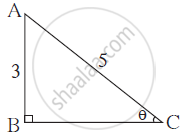Advertisements
Advertisements
प्रश्न
Prove that:
`"tanθ"/("secθ" – 1) = (tanθ + secθ + 1)/(tanθ + secθ - 1)`
उत्तर १
`"tanθ"/("secθ" – 1) = (tanθ + secθ + 1)/(tanθ + secθ - 1)`
RHS = `(tanθ + secθ + 1)/(tanθ + secθ - 1)`
`"RHS" = (tanθ + secθ + 1)/((tanθ + secθ) - 1) × (tanθ + secθ + 1)/((tanθ + secθ) + 1) ...("On rationalising the denominator")`
`"RHS" = ((tanθ + secθ + 1)^2)/((tanθ + secθ)^2 - 1)`
`"RHS" = (tan^2θ + sec^2θ + 1 + 2tanθsecθ + 2tanθ + 2secθ)/(tan^2θ + 2tanθ.secθ + sec^2θ - 1) ...{((a + b + c)^2 = a^2 + b^2 + c^2 + 2ab + 2ac + 2bc),((a + b)^2 = a^2 + 2ab + b^2):}`
`"RHS" = ((1 + tan^2θ) + sec^2θ + 2tanθsecθ + 2tanθ + 2secθ)/(tan^2θ + 2tanθ.secθ + (sec^2θ - 1))`
`"RHS" = (sec^2θ + sec^2θ + 2tanθsecθ + 2tanθ + 2secθ)/(tan^2θ + 2tanθ.secθ + tan^2θ)`
`"RHS" = (2sec^2θ + 2tanθsecθ + 2tanθ + 2secθ)/(2tan^2θ + 2tanθ.secθ)`
`"RHS" = [2secθ (tanθ + secθ) + 2(tanθ + secθ)]/[2tanθ(tanθ + secθ)]`
`"RHS" = [(2secθ + 2)(cancel(tanθ + secθ))]/[2tanθ(cancel(tanθ + secθ))]`
`"RHS" = [cancel2(secθ + 1)]/[cancel2(tanθ)]`
`"RHS" = (secθ + 1)/(tanθ)`
`"RHS" = (secθ + 1)/(tanθ) × (secθ - 1)/(secθ - 1)`
`"RHS" = (sec^2θ - 1)/(tanθ(secθ - 1)) ...[(a - b)(a + b) = a^2 - b^2]`
`"RHS" = (tan^cancel2θ)/(canceltanθ(secθ - 1))`
`"RHS" = tanθ/(secθ - 1)`
LHS = `"tanθ"/("secθ" – 1)`
LHS = RHS
Hence proved.
उत्तर २
`"tanθ"/("secθ" – 1) = (tanθ + secθ + 1)/(tanθ + secθ - 1)`
LHS = `"tanθ"/("secθ" – 1)`
`"LHS" = "tanθ"/("secθ" – 1) × ("secθ" + 1)/("secθ"+ 1) ...("On rationalising the denominator")`
`"LHS" = ("tanθ"("secθ" + 1))/("sec"^2θ" - 1) ...[(a + b)(a - b) = a^2 - b^2]`
`"LHS" = ("tanθ"("secθ" + 1))/("tan"^2θ") ...{(∵ 1 + tan^2θ = sec^2θ),(∵ sec^2θ - 1 = tan^2θ):}`
`"LHS" = ("secθ" + 1)/"tanθ"`
∴ `"tanθ"/("secθ" – 1) = ("secθ" + 1)/"tanθ"`
∴ By theorem on equal ratios,
`"tanθ"/("secθ" – 1) = ("secθ" + 1)/"tanθ" = (tanθ + (secθ + 1))/((tanθ) + secθ - 1)`
`"LHS" = (tanθ + secθ + 1)/(tanθ + secθ - 1)`
`"RHS" = (tanθ + secθ + 1)/(tanθ + secθ - 1)`
LHS = RHS
Hence proved.
संबंधित प्रश्न
`"If "\frac{\cos \alpha }{\cos \beta }=m\text{ and }\frac{\cos \alpha }{\sin \beta }=n " show that " (m^2 + n^2 ) cos^2 β = n^2`
Evaluate without using trigonometric tables:
`cos^2 26^@ + cos 64^@ sin 26^@ + (tan 36^@)/(cot 54^@)`
Prove the following trigonometric identities.
`sin^2 A + 1/(1 + tan^2 A) = 1`
Prove the following trigonometric identities.
`tan^2 theta - sin^2 theta tan^2 theta sin^2 theta`
Prove the following trigonometric identities.
`tan theta/(1 - cot theta) + cot theta/(1 - tan theta) = 1 + tan theta + cot theta`
If `(x/a sin a - y/b cos theta) = 1 and (x/a cos theta + y/b sin theta ) =1, " prove that "(x^2/a^2 + y^2/b^2 ) =2`
If m = ` ( cos theta - sin theta ) and n = ( cos theta + sin theta ) "then show that" sqrt(m/n) + sqrt(n/m) = 2/sqrt(1-tan^2 theta)`.
Write the value of `(1 + cot^2 theta ) sin^2 theta`.
If `cosec theta = 2x and cot theta = 2/x ," find the value of" 2 ( x^2 - 1/ (x^2))`

From the figure find the value of sinθ.
sec4 A − sec2 A is equal to
Prove the following identity :
(secA - cosA)(secA + cosA) = `sin^2A + tan^2A`
Prove the following identity :
`1/(cosA + sinA - 1) + 2/(cosA + sinA + 1) = cosecA + secA`
Prove the following identity :
`(cosecθ)/(tanθ + cotθ) = cosθ`
There are two poles, one each on either bank of a river just opposite to each other. One pole is 60 m high. From the top of this pole, the angle of depression of the top and foot of the other pole are 30° and 60° respectively. Find the width of the river and height of the other pole.
Prove that `sin^2 θ/ cos^2 θ + cos^2 θ/sin^2 θ = 1/(sin^2 θ. cos^2 θ) - 2`.
Prove that: sin6θ + cos6θ = 1 - 3sin2θ cos2θ.
Choose the correct alternative:
cos θ. sec θ = ?
Prove that `sqrt(sec^2 theta + "cosec"^2 theta) = tan theta + cot theta`
(1 + sin A)(1 – sin A) is equal to ______.
